|
The title
above obviously is not consistent with history. The Henry rifle was
never chambered originally for the 45 Long Colt cartridge. Or for the
44-40, as so many today think. It
was the rimfire 44 Henry round or 44 Flat as it was called, that the
original Henry fired. And a
little later, after the War Between the States, a centerfire version of the
.44 Flat was also made available, but wasnít well known.
The
Winchester 1873 was really the 44 WCF mainstay.
Remington when using that cartridge in chambering guns or
manufacturing ammo called it the 44-40 not 44 WCF... As they did with the
32 WCF to 32-20, and the 38WCF to 38-40. They didnít want to give credit to the name Winchester
Center Fire...or impinge on Winchester's copyrights.
So
it took the great company of Uberti a 135 years or so later, to
chamber the Henry rifle in my favorite caliber, 45 Long Colt. My rifle is about 15 years old, and is fairly consistent with
the originals. The action is
the same and in brass... though hardness testing shows it to be stronger
than the brass of the 1800s. The
bolt is of steel and the bolt throw is lengthened to cycle the longer 45
long Colt round, as well as the other Winchester WCF rounds.
Brass is very strong, and the pressures for the Henry being kept
below 18,000 psi in the modern rifles is no problem.
The weakness in the design is in the toggle link.
It was great with the black powder of Tyler Henryís day..
But smokeless powder can and has damaged even the strongest of the modern
Henry, 1866, and 1873 rifles and carbines.
And with the large case head of the 38 WCF, the 44 WCF, and of
course that of the 45 Colt ...pressures must be kept down even in the
modern rifles.
I
can load my 1873 Uberti Deluxe Short Rifle
with somewhat higher pressures because it is all steel inside and out, and
chambered for the small .357 case head.
But thatís all right, the 45 Colt from the 24 inch barrel of my
Henry easily tops 1200 fps with a 255 grain cast bullets.
And in the 10.5 pound rifle there is little to no recoil.
It is fun to shoot, and it is deadly at reasonable ranges. And I
have no problem hunting good sized hogs with it, since I have killed them
with the same velocity and bullet weight from handguns.
Whitetail deer at 75 yards to a set shot at about 100 yards, is also
possible if you can hit what you aim at... black bear gets iffy.
Only at close range for me... or a set head shot at longer range.
The
Henry rifle, as most know, loads
using a different system then the later leverguns. Pulling the spring loaded column button all the way to the muzzle and turning the barrel shroud opens
the loading tube. The rounds
are fed in primer first and when full, the shroud is turned even again with
the barrel and loading tube and the button presses down on the ammo,
activating the actions ability to be cycled with a loaded round each time
from the tube. See photo...
It
is
said often that the weakness of the Henry was the necessary open channel
along the bottom of the loading tube.
That it would get packed with dirt or bent hindering the function of
the levergun. And I can see
where that would happen, especially in hot war time fire fights. But Iím sure the settlers that took the Henrys with them
across this great land, for protection from hostiles and robbers, were able
to be a lot more careful than war time conditions.
The
original
44 Henry Flat we tested (using ammo manufactured in 1870) gave about the
power of a 38 Special plus P from a six inch handgun, at the muzzle.
Certainly a 255 grain 45 cast bullet or a 240 grain 44 cast bullet
at 1200 fps is considerably more powerful.
Getting a 158 grain bullet to 1000 fps from a 38 special plus P is
no problem, and that gives 350 plus lbs of muzzle energy... Thatís about
the power level of the .44 Henrys
produced in the 1870s and 1880s. Whereas
the 45 Colt from my modern Henry goes 1200 fps with 255 grain cast bullet
and gives 815 ft. pounds for a 465 lb difference over the 44 Flat.
Of course the 44 Flat was a .430 caliber and that helped the killing
power over the .358 caliber of a 38 special.
Brass
can
be polished to a very bright shine, as I know from putting that brilliance
on the Acuírzr tools I manufacture.
But thatís not what I want when hunting... The Uberti comes with
ladder sights, that are regulated for the 44 Flat I guess. Because even with original ballistics and originally shaped
bullets in 45 long Colt the gradients donít match the bullet drop.
But thatís no problem, as I quickly learned where to set the
sights for under 50 yards and out to 100 yards.
And it is a blast setting the ladder sights for really long range
and dropping bullets into a target out to 350 to 400 yards..... Good only
for killing rocks and such... but loads of fun.
Someone
told
me the Henry wasnít practical...obviously not a levergun man.
Itís fun to hunt with the old timers, and they will do the job if
we do ours. I get 1 and 3/4ths
inches at 50 yards with select cast reloads off the bench ...so accuracy is
not a problem... I use the Keith shaped cast bullet and it is much
more deadly than the original semi-cone shaped 45 Colt bullet of the same
weight. And in heavy timber,
brushy country and such, the smooth action of the Henry, the 66, and 73,
make all the difference in the world for a fast second shot if needed.
This
Henry
brings to me visions of mounted men and wagon trains.
Circled wagons and campfires... and surprised raiders finding the
fire power of lever action rifles for the first time....
Paco
Kelly
  
Got something to say about this article? Want to agree (or
disagree) with it? Click the following link to go to the GUNBlast Feedback Page.
|
|
Click pictures for a larger version.
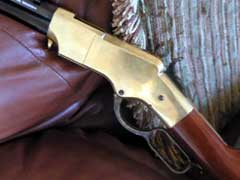
Uberti's 1860 "Henry" replica in .45 Long
Colt.
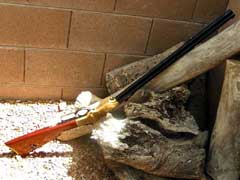
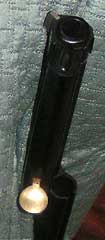
The 1860's magazine tube design loads from the muzzle
end.
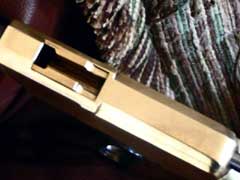
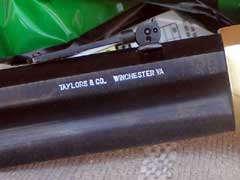

Paco's Uberti 1860 was imported by Taylors & Co.

A good .45 Colt Peacemaker-style sixgun, such as this
Uberti, makes a perfect companion for the 1860 rifle.

Proven in battle and hunting fields for almost 150
years, the 1860 is still a useful rifle today.
|
![]()